This post may contain affiliate links. If you make a purchase through links on our site, we may earn a commission.
Hens and chicks plants make great low-maintenance options for dry, sunny gardens. And there are so many interesting cultivars available in a range of hues, from chocolate brown to green to bright orange and yellow. The common name may be confusing until you grow them yourself and realize it makes sense. One main rosette (mama hen) will eventually produce several offsets or babies (the chicks!). Though I’ve never heard them referred to by houseleeks, their other common name, the Latin name you’ll see on plant tags for these popular succulents is Sempervivum. They are members of the stonecrop family (Crassulaceae).
Just to get into the weeds a bit, there are some varieties of Echeveria that are referred to as hens and chicks for the same reason. They are also part of the Crassulaceae family, but of a different genera than Sempervivum plants, and produce those baby plantlets around the main rosette. They also send up a flower, but on a thinner stem. Sempervivums are native to Europe, Western Asia, and Morocco. And there are a few types—Sempervivum tectorum, Sempervivum calcareum, etc. Echeveria are native to parts of the United States and South America.

Where to plant hens and chicks
Hens and chicks plants are often included in xeriscaping plant lists because of their drought tolerance. They also make great groundcovers, as they slowly spread along the ground. And that penchant for drier soils also makes hens and chicks good choices for rock gardens. Many varieties of hens and chicks are hardy down to zone 3—areas where the winter temperature dips to between -40°F to -30°F (-40°C to -34.4°C). Read your plant tag carefully before planting.

Choose a spot that gets direct sun (some partial shade is okay) and very well-draining soil. In fact, the soil doesn’t have to be that great as the plants don’t mind sandier soils. Because hens and chicks are low to the ground, make sure they’re in front of taller perennials, so you can actually see them shine in the garden.

Adding hens and chicks plants to a garden
In your planting site of either loose, well-draining soil or soil that’s more comprised of grit and gravel, you probably won’t even need a trowel to dig a hole as the root system will sit fairly shallowly in the soil. You’ll see when you pop the plant out of its cell or container. You can probably scrape away about three inches (8 cm) with your gloved hand. Gather soil back around the plant to cover the roots and press down gently. Water your new plant.
If you’re lucky, your hens and chicks plant will flower. The only downside is that the plant usually dies after flowering.

Planting hens and chicks in pots
If you’d like to plant up a container, choose one with excellent drainage made of terracotta or clay. Fill it with a potting mix formulated for cacti and succulents. It provides good drainage via ingredients, like sand, pumice, gravel, and perlite. Too much moisture or potting soil that drains too slowly, can lead to root rot. Let the soil dry out completely between watering. Plants can be watered about once a week. And avoid saturating the soil when you do water.

Caring for hens and chicks plants
As mentioned, hens and chicks are pretty low maintenance. Water them regularly until they’re established. But be careful not to overwater. And the plants don’t really require fertilizer.
After the plant flowers, you can remove the flower stalk with hand pruners. When rosettes die back, you can remove the dead, desiccated leaves, but be very careful when doing so. The rosettes have very shallow roots, so I’ve inadvertently pulled up some living rosettes when trying to remove dead parts of the plant. If that happens, you can replant them easily, even in a new location. But just be mindful when gently pulling those dried out leaves away.

As your plant grows, it will start to produce chicks, slowly spreading as a groundcover, or spilling over the sides of a container. These chicks can easily be planted elsewhere as they root easily, like other succulents.
What to do with hens and chicks plants in the winter
Hens and chicks are hardy down to between roughly -40°F and -30°F (-40°C to -34.4°C), so they should be okay to leave in the garden as the plants go dormant. However if you have planted them in pots, dig the pot into the soil of a garden during the winter months. If the pot is terracotta or clay, you may want to transfer them out to a pot that won’t be damaged by being buried or frozen solid.




Leave a Reply